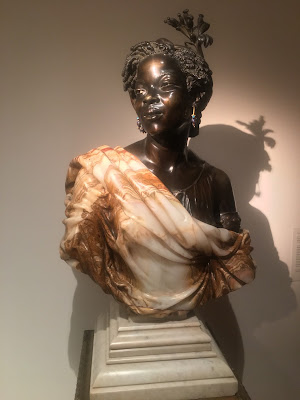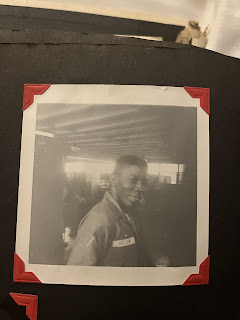On Erasure and a Bust
Yesterday, I went with a couple of friends to the Museum Mile Festival held every year here in New York City. This festival features museums on 5th Avenue, between 82nd and 110th streets opening their doors for free from 6-9pm. We visited the famed Metropolitan Museum of Art on a whim (and because the Costume Institute is a must) and it was one of the best, most interesting museum experiences I've had.
While walking through the European sculpture and decoriate arts collection, we were all struck by the sight of one statue in particular. Placed close to a corner was an Algerian onyx-marble, bronze and gilt bronze, and enamel bust of a North African woman living in France entitled La Capresse des Colonies. I gravitated toward her, immediately intrigued and wanting to know more. Imagine my disappointment when I saw the plaque next to her spoke solely about the artist, Charles-Henri-Joseph Cordier, and his and the piece's travels. Absolutely no mention of the art itself much less the woman depicted. This agitated me more than I expected it to. Oh look! Some erasure! My only question was and still is this: why don't we know her name? I'm not suggesting we have her entire life's history transcribed next to her likeness but she has been robbed even the simple dignity of the public, and the history books, knowing her name. The statue is stunning, the detail and colors exquisite, and yet no mention of the woman herself. How can you study the art without also studying and knowing who the art represented? You want to know the reason why? Because it wasn't deemed important. This bust was crafted in 1861, a time when African women, in any country, were not seen as "women" in the same way white women were. Sure they were female, but blacks were "different" and not categorized the same. As a result, it was determined, perhaps not expressly or in writing but in an altogether more insidious way, her name was not necessary and therefore no record has it. And yes, I did actually do some digging instead of just looking at the plaque and leaving in a huff. Black women have been seen as unimportant for much too long. We are critical to shaping society in so many ways and yet we are hardly ever given credit where credit is due. The argument here is simple: GIVE CREDIT WHERE CREDIT IS DUE. If you're going to use a black woman's art, idea, likeness in art, do us the courtesy of telling us her name. It's really that simple. It's about time common courtesy finally trumped cultural appropriation. The artist went so far as to not only not give her name, he also carved his name into her earrings. Really sir? Her earrings? Typically statues and busts have artists names or insignias near the base, or the underside of the statue. But no, good ol' Chuck Cordier decided her earrings, more than once, was the place his name should go. People could forget this beautiful African woman's name but not his. Though Cordier did site his wish to open a dialogue about the universality of beauty, he neglected to tell us his beautiful model's name. Oh Charles, if only you had taken that extra step...
Here are some photos of the lovely, nameless, lady:
This problem is systemic and has got to end. Stop stripping women of color of our right to artistic inclusion and public acknowledgment. If you were inspired by us, then say so. Black women are people who deserve to be recognized. In closing, the next time I see an onyx-marble and gilt bronze bust of a black woman, I expect to see her name on the accompanying plaque.
xx
While walking through the European sculpture and decoriate arts collection, we were all struck by the sight of one statue in particular. Placed close to a corner was an Algerian onyx-marble, bronze and gilt bronze, and enamel bust of a North African woman living in France entitled La Capresse des Colonies. I gravitated toward her, immediately intrigued and wanting to know more. Imagine my disappointment when I saw the plaque next to her spoke solely about the artist, Charles-Henri-Joseph Cordier, and his and the piece's travels. Absolutely no mention of the art itself much less the woman depicted. This agitated me more than I expected it to. Oh look! Some erasure! My only question was and still is this: why don't we know her name? I'm not suggesting we have her entire life's history transcribed next to her likeness but she has been robbed even the simple dignity of the public, and the history books, knowing her name. The statue is stunning, the detail and colors exquisite, and yet no mention of the woman herself. How can you study the art without also studying and knowing who the art represented? You want to know the reason why? Because it wasn't deemed important. This bust was crafted in 1861, a time when African women, in any country, were not seen as "women" in the same way white women were. Sure they were female, but blacks were "different" and not categorized the same. As a result, it was determined, perhaps not expressly or in writing but in an altogether more insidious way, her name was not necessary and therefore no record has it. And yes, I did actually do some digging instead of just looking at the plaque and leaving in a huff. Black women have been seen as unimportant for much too long. We are critical to shaping society in so many ways and yet we are hardly ever given credit where credit is due. The argument here is simple: GIVE CREDIT WHERE CREDIT IS DUE. If you're going to use a black woman's art, idea, likeness in art, do us the courtesy of telling us her name. It's really that simple. It's about time common courtesy finally trumped cultural appropriation. The artist went so far as to not only not give her name, he also carved his name into her earrings. Really sir? Her earrings? Typically statues and busts have artists names or insignias near the base, or the underside of the statue. But no, good ol' Chuck Cordier decided her earrings, more than once, was the place his name should go. People could forget this beautiful African woman's name but not his. Though Cordier did site his wish to open a dialogue about the universality of beauty, he neglected to tell us his beautiful model's name. Oh Charles, if only you had taken that extra step...
Here are some photos of the lovely, nameless, lady:
This problem is systemic and has got to end. Stop stripping women of color of our right to artistic inclusion and public acknowledgment. If you were inspired by us, then say so. Black women are people who deserve to be recognized. In closing, the next time I see an onyx-marble and gilt bronze bust of a black woman, I expect to see her name on the accompanying plaque.
xx




Comments
Post a Comment